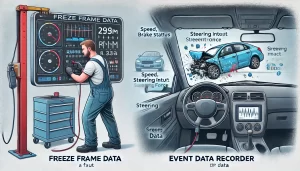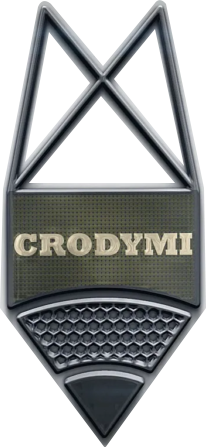
Freeze Frame Data vs. EDR Data: What Every Driver and Investigator Should Know
Published on February 8, 2025
By Ricardo Mitchell, M.S., B.S.
In today’s automotive landscape, understanding vehicle diagnostics is crucial—especially when it comes to accident investigations. Two types of data often discussed are Freeze Frame Data and Event Data Recorder (EDR) Data. While both capture critical vehicle information, they serve distinct purposes and come with different retrieval costs and accessibility. In this post, we’ll break down the differences, explain why each is important, and offer insights on cost and accessibility. For more expert automotive insights, visit Crodymi Electronic Data Retrieval Services.
What Is Freeze Frame Data?
Freeze Frame Data is a snapshot of a vehicle’s operational parameters recorded at the moment a diagnostic trouble code (DTC) is triggered. It typically includes information such as:
- Engine temperature
- Vehicle speed
- RPM (Revolutions Per Minute)
- Sensor readings (e.g., throttle position, fuel system status)
Purpose:
Freeze Frame Data is used by mechanics and technicians to diagnose engine and emissions issues. It helps identify the conditions that led to a malfunction, providing valuable clues during routine service checks or when a fault occurs.
Key Points:
- When Captured: Triggered by the vehicle’s On-Board Diagnostic (OBD-II) system during specific faults.
- Data Focus: Mainly engine and emissions-related data.
- Cost of Retrieval: Generally low—often free during routine diagnostics or costing between $0 to $200 with basic OBD-II scanners.
Learn more about OBD-II systems on the NHTSA website.
What Is EDR (Event Data Recorder) Data?
EDR Data functions much like an airplane’s black box, recording detailed information before, during, and after a significant event such as a crash or severe braking event. This data typically includes:
- Vehicle speed and acceleration
- Brake application and throttle position
- Steering input and seatbelt status
- Airbag deployment details
Purpose:
EDR Data is primarily used for accident investigation and crash reconstruction. It provides a timeline of events that can validate witness statements, support legal proceedings, and assist insurance claims.
Key Points:
- When Captured: Recorded during significant safety events like hard braking, rapid deceleration, or collisions.
- Data Focus: Detailed crash and safety system performance.
- Cost of Retrieval: Generally higher—ranging from $300 to over $5,000 due to the need for specialized tools and expertise.
For additional insights into EDR systems, check out resources from Bosch’s official website.
Why Both Data Types Matter in Accident Investigations
Accurate accident reconstruction often depends on gathering as much data as possible. Here’s why each data type is essential:
Event Data Recorder (EDR) Data
- Crash Reconstruction: Offers a clear picture of driver inputs and vehicle dynamics at the time of the accident.
- Legal and Insurance Evidence: Validates witness accounts and supports claims.
- Priority in Investigations: Due to its direct insight into the events surrounding a crash.
Freeze Frame Data
- Mechanical Diagnostics: Helps determine if a vehicle malfunction (e.g., brake failure or engine stalling) contributed to the accident.
- Secondary but Valuable: Provides context when mechanical issues are suspected.
By retrieving both types of data when needed, investigators can differentiate between driver error and mechanical failure. For fleet managers and accident reconstruction experts, this dual approach is invaluable.
The Cost Difference: Freeze Frame vs. EDR Data
The costs associated with retrieving these data types vary significantly:
| Data Type | Retrieval Cost | Tools Required | Retrieved By |
|---|---|---|---|
| Freeze Frame Data | $0 – $200 | Basic OBD-II scanner (costs range: $20 – $500) | Mechanics, Technicians, DIY enthusiasts |
| EDR Data | $300 – $5,000+ | Specialized EDR retrieval tools (e.g., Bosch CDR systems costing $2,000 – $20,000+) | Certified Crash Data Analysts, Law Enforcement, Accident Reconstruction Experts |
Key Consideration:
While Freeze Frame Data is easily accessible to most mechanics, EDR data requires specialized equipment, technical expertise, and sometimes legal permission due to privacy concerns.
Can Mechanics Retrieve EDR Data?
In general, most mechanics cannot retrieve EDR data due to the following reasons:
- Specialized Equipment: EDR extraction tools are expensive and manufacturer-specific.
- Restricted Access: Manufacturers may limit access to EDR data, reserving it for certified professionals.
- Legal and Privacy Concerns: Unauthorized retrieval of EDR data can lead to legal issues.
However, exceptions exist if mechanics have the proper tools (like the Bosch CDR system) and training, or if they work alongside law enforcement or certified accident reconstruction experts.
Conclusion
Both Freeze Frame Data and EDR Data play crucial roles in vehicle diagnostics and accident investigations. Understanding their differences, retrieval costs, and proper usage can significantly impact accident reconstruction and liability assessments.
For more in-depth articles on automotive diagnostics, crash investigation tools, and best practices in vehicle maintenance, be sure to explore our resources at Crodymi.com.
Additional Resources:
- National Highway Traffic Safety Administration (NHTSA) – Comprehensive guides on vehicle safety and OBD-II regulations.
- Bosch Mobility Solutions – Insights into advanced EDR retrieval systems and automotive technology.
Stay informed, drive safe, and let Crodymi.com be your trusted resource for automotive diagnostic tools and expert insights.
Meta Description:
Discover the key differences between Freeze Frame Data and EDR Data, their roles in accident investigations, cost differences, and why both matter. Learn more at Crodymi.com—your trusted source for automotive diagnostics and crash investigation insights.
Keywords: Freeze Frame Data, EDR Data, Accident Investigation, OBD-II, Crash Reconstruction, Automotive Diagnostics, Crodymi, EDR Retrieval, Vehicle Safety

